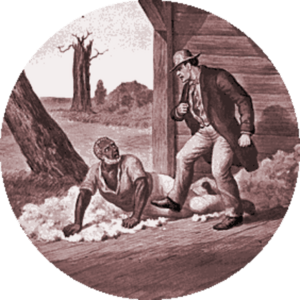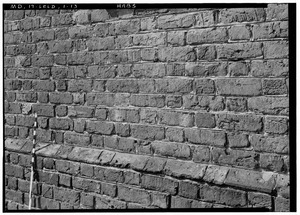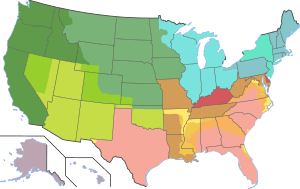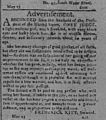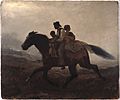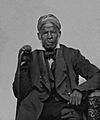Slavery in the United States facts for kids
Slavery in the United States began a long time ago, when Europeans first settled in what became the United States. Slavery was practiced in the British colonies, including the first thirteen colonies that formed the United States. Under the law, an enslaved person was treated like property. This meant they could be bought, sold, or given away.
Enslaved people had to work without pay and were not allowed to make their own choices. They were forced to work on farms and plantations, growing crops like tobacco and cotton. They also worked in homes and other jobs. Conditions were often very harsh. Enslaved people were often whipped or beaten if they did not work fast enough or if they tried to resist.
Enslaved people had very few rights. They could not own property or learn to read or write. They were not allowed to travel without permission. They could not marry legally, and their families could be separated at any time.
Many people in the United States believed slavery was wrong. They worked hard to end it. These people were called abolitionists. Some famous abolitionists included:
Slavery lasted in about half of U.S. states until it was ended in 1865. This happened with the Thirteenth Amendment to the U.S. Constitution.
Slavery was a very difficult time in American history. Learning about it helps us understand how far we have come. It also shows us how important it is to treat everyone with fairness and respect.
Contents
How Slavery Started in America
Slavery began in the early 1600s. European settlers in North America needed many workers for their farms. At first, they used indentured servants. These were people who worked for a set number of years to pay off a debt. Later, settlers started enslaving Africans. The first enslaved Africans arrived in Jamestown, Virginia, in 1619.

During most of the British colonial period, slavery existed in all the colonies. In the North, enslaved people usually worked as house servants, skilled workers, or laborers in cities. Many men worked on docks and in shipping. In the South, enslaved people worked on farms. They grew crops like indigo, rice, and tobacco. Cotton became a major crop later, after the 1790s. By 1720, about 65 percent of South Carolina's population was enslaved.
Slavery and the American Revolution
When the Revolutionary War started, the British needed more soldiers. British leaders offered freedom to enslaved people who belonged to American Patriots. They said if these enslaved people joined the British, they would be free. Many enslaved people, up to 100,000, ran away to the British side.
These formerly enslaved people formed military units and fought in the war. Enslaved women and children worked as laborers and house servants. Many enslaved people used the war's chaos to escape their plantations. They either went to British lines or blended into the general population.
At the end of the war, the British helped many freedmen leave. They also took enslaved people owned by those who supported the British (Loyalists). About 15,000 black loyalists left with the British. Most of them became free people in England or other British colonies.
The U.S. Constitution and Slavery
Slavery was a difficult topic at the 1787 Constitutional Convention. Many of the Founding Fathers of the United States owned many enslaved people. The words "slave" and "slavery" were not used directly in the Constitution when it was first written. However, some parts clearly referred to enslaved people and slavery. The Constitution did not ban slavery until the 13th Amendment was added in 1865.
Enslaved people in the early United States could not vote and had almost no rights. However, they were counted in population counts. For representation in the U.S. Congress, each enslaved person was counted as three-fifths of a person.
After the Revolution
In the years after the American Revolution, some states and individuals worked to free enslaved people. Northern states created new laws that included equal rights or directly ended slavery. By 1804, all Northern states had passed laws to outlaw slavery. Some ended it right away, others over time. In New York, the last enslaved people were freed in 1827.
"A Necessary Evil"
In the 1800s, some people who supported slavery called it a "necessary evil." They feared that freeing enslaved Black people would cause more problems for society and the economy than keeping slavery. On April 22, 1820, Thomas Jefferson, one of the Founding Fathers of the United States, wrote in a letter:
We have the wolf by the ear, and we can neither hold him, nor safely let him go. Justice is in one scale, and self-preservation in the other.
A big issue in the 1840s and 1850s was whether slavery should be allowed in new states. These new states were made from lands like the Louisiana Purchase and Mexican Cession. The Compromise of 1850 tried to solve this problem.
The compromise did several things:
- It allowed California to join the United States as a free state.
- It made laws stronger for catching and returning enslaved people who had escaped. This was called the Fugitive Slave Act of 1850.
- It banned the slave trade in Washington, D.C., but slavery itself was still allowed there.
- It set borders for Texas and created new territories like New Mexico and Utah. It did not say if future states from these territories would be free or slave.
The Underground Railroad
The Fugitive Slave Act of 1850 made it a law that people in free states had to help catch and return enslaved people. Many people in free states and cities like Philadelphia, New York, and Boston resisted this law. Enslaved people continued to escape from the South. They crossed the Ohio River and the Mason–Dixon line into the North and Canada. They used a secret network called the Underground Railroad.
The Underground Railroad was a secret system of people who helped enslaved people escape to freedom. Some white Northerners helped hide formerly enslaved people from their owners. They also helped them reach freedom in Canada.
Harriet Tubman was one of the most famous leaders on the Underground Railroad. She had been an enslaved person herself. She made many trips back to the South to help others escape. She was known as the "Moses of her people."
The Civil War
The issue of slavery caused a lot of tension between the northern and southern states. The southern states depended on slavery for their economy. The northern states did not. This tension led to the Civil War in 1861. During the war, President Abraham Lincoln issued the Emancipation Proclamation in 1863. This document declared that all enslaved people in the Confederate states were free.
The war ended on June 22, 1865. After the South surrendered, the Emancipation Proclamation was put into effect in all remaining parts of the South. Slavery officially continued for a few more months in some places. Federal troops arrived in Galveston, Texas, on June 19, 1865, to make sure emancipation happened there. This event is now celebrated as Juneteenth National Independence Day, which became a national holiday in 2021.
The Emancipation Proclamation
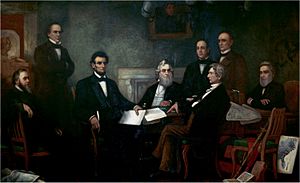
The Emancipation Proclamation was an order given by President Abraham Lincoln on January 1, 1863. It instantly changed the legal status of three million enslaved people in certain areas of the Confederacy from "slave" to "free." This meant that as soon as an enslaved person escaped their owner's control, they became truly free.
Plantation owners knew that emancipation would ruin their economic system. So, they sometimes moved their enslaved people far away from the Union army. By June 1865, the Union Army controlled all of the Confederacy. They had freed all the enslaved people mentioned in the Proclamation.
The End of Slavery
The Thirteenth Amendment to the U.S. Constitution officially ended slavery. It said that slavery was not allowed, except as punishment for a crime. The Senate passed it in April 1864, and the House of Representatives passed it in January 1865.

The amendment became law when three-fourths of the states approved it. This happened on December 6, 1865, when Georgia approved it. On that day, the last 40,000–45,000 enslaved Americans in Kentucky and Delaware were freed. Also, about 200 people who were still in a very slow process of emancipation in New Jersey were freed.
Interesting Facts About Slavery
- The Underground Railroad helped about 100,000 enslaved people escape to freedom.
- Harriet Tubman made 19 trips to the South. She helped free over 300 people.
- The Emancipation Proclamation did not free all enslaved people right away. It only applied to states that were fighting against the Union.
Important Terms
- Enslaved People: Individuals who were forced into slavery and treated as property.
- Abolitionists: People who actively worked to end slavery.
- Emancipation Proclamation: A document issued by President Lincoln during the Civil War. It declared freedom for many enslaved people in the Confederate states.
Images for kids
-
Slave auction block, Green Hill Plantation, Campbell County, Virginia, Historic American Buildings Survey
-
Ledger of sale of 118 slaves, Charleston, South Carolina, c. 1754
-
Prince Estabrook memorial in front of Buckman Tavern on Lexington Green in Lexington, Massachusetts. Prince Estabrook, who was wounded in the Battle of Lexington and Concord, was the first black casualty of the Revolutionary War.
-
This postage stamp, created for the Bicentennial, honors Salem Poor. He was an enslaved African-American man who bought his freedom, became a soldier, and was a hero during the Battle of Bunker Hill.
-
Advertisement in The Pennsylvania Gazette, May 24, 1796, seeking the return of Oney Judge, a fugitive slave who had escaped from the household of George Washington.
-
Confederate $100 bill, 1862–63, showing slaves farming. John C. Calhoun is at left, Columbia at right.
-
This portrait of Judge Samuel Sewall by John Smibert is in the Museum of Fine Arts, Boston Massachusetts.
-
Establishing the Northwest Territory as free soil—no slavery—by Manasseh Cutler and Rufus Putnam proved to be crucial to the outcome of the Civil War.
-
Statue of abolitionist and crusading minister Theodore Parker in front of the Theodore Parker Church in West Roxbury, Massachusetts.
-
Statue of prominent abolitionist Frederick Douglass in the Highland Park Bowl in Rochester, New York. Douglass was a great admirer of Theodore Parker.
-
Benjamin Kent, Old Burying Ground, Halifax, Nova Scotia
-
Henry Clay (1777–1852), one of three founders of the American Colonization Society, which assisted free blacks in moving to Africa. Liberia was a result.
-
Ashley's Sack is a cloth that recounts a slave sale separating a mother and her daughter. The sack belonged to a nine-year-old girl Ashley and was a parting gift from her mother, Rose, after Ashley had been sold. Rose filled the sack with a dress, braid of her hair, pecans, and "my love always"
-
Slave sale, Charleston, 1856
-
U.S. brig Perry confronting the slave ship Martha off Ambriz on June 6, 1850
-
Eastman Johnson's 1863 painting "The Lord is My Shepherd"
-
Slaves for sale, a scene in New Orleans, 1861
-
Mixed-race slave girls of predominant European ancestry, New Orleans, 1863 (see also white slave propaganda).
-
Five-dollar banknote showing a plantation scene with enslaved people in South Carolina. Issued by the Planters Bank, Winnsboro, 1853. On display at the British Museum in London.
-
Eastman Johnson (American, 1824–1906). A Ride for Liberty—The Fugitive Slaves (recto), ca. 1862. Oil on paperboard. Brooklyn Museum
-
Uncle Marian, a slave of great notoriety, of North Carolina. Daguerreotype of elderly North Carolina slave, circa 1850.
-
Slaves on J. J. Smith's cotton plantation near Beaufort, South Carolina, photographed by Timothy O'Sullivan standing before their quarters in 1862
-
Four generations of a slave family, Smith's Plantation, Beaufort, South Carolina, 1862
-
Many Native Americans were enslaved during the California Genocide by American settlers.
See also
 In Spanish: Esclavitud en los Estados Unidos para niños
In Spanish: Esclavitud en los Estados Unidos para niños


